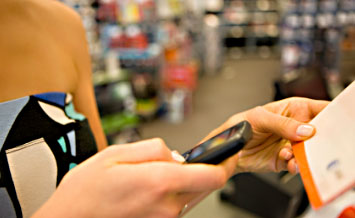 Here’s the latest dispatch from the brave new world of retail:
Here’s the latest dispatch from the brave new world of retail:
Catalina, a marketing company that tracks billions of purchases each year, is using a shopper’s location in store aisles to refine offers. Last year, Stop & Shop’s Ahold division introduced a mobile app, now run by Catalina, that allows shoppers to scan products. When they do, Catalina identifies them through their frequent shopper number or phone number, and knows where in the store they are. Special e-coupons are created on the spot.
“If someone is in the baby aisle and they just purchased diapers,” said Todd Morris, an executive vice president at Catalina, “we might present to them at that point a baby formula or baby food that might be based on the age of their baby and what food the baby might be ready for.”
As a person who loathes loyalty cards, you can imagine what I think of this. Actually, though, it doesn’t raise my heartburn level too much higher than it already is. It’s just the electronic equivalent of stationing someone who gives out free samples at strategic places in the store. Still, pretty fascinating, no? You can now just wander the aisles and get offered different coupons depending on where you are and what you’ve purchased previously.
Generally speaking, though, my big problem with this kind of thing is summarized in this sentence from the story: “Retailers are counting on most people accepting the trade-off if it means they get a better price for a product they want.” But if someone is getting a better price, then someone else is getting a worse price. And price discrimination is getting bigger all the time. Here’s a wee story.
A couple of years ago I was shopping a little ways away from my usual haunts. But there was a Petco nearby and I remembered I needed cat litter. So I dropped in and grabbed a box. “Do you want to sign up for our card?” asked the checker. No thanks. “Are you sure? You can save a lot of money?” No, no, just sell me the litter. So he did, I tossed it in the car, and drove off.
And then did a double take halfway out of the parking lot. Just how much did that stuff cost me? I looked at the receipt, and it was about 50% more than the price I usually paid at the supermarket. (That’s 50% more than the everyday price, not some special sale price.) I hadn’t noticed because, of course, the loyalty card price had been prominently displayed and the regular price was listed underneath in small type. And anyway, I don’t buy cat litter often enough for the usual price to be etched into my consciousness.
When the difference in price is 5%, that’s one thing. But the non-loyalty penalty seems to be getting bigger all the time, and this means that, for all practical purposes, you can only shop at stores where you have a loyalty card. If you just dash into some random place, there’s a good chance you’re going to get robbed.
This is the price we pay for the loyalty card revolution. If it actually saved us all money, maybe that would be an acceptable price to pay. But you all know that’s a mirage, right? The aggregate price that supermarkets charge is about the same as it would be without loyalty cards. How could it not be? So now our shopping choices are restricted; we have to jump through a growing number of hoops to get the best pricing (it’s not just clipping coupons anymore!); anyone who’s not especially computer savvy is routinely ripped off; and gigabytes of your personal consumption data is available to anyone willing to pay a few pennies for it. What’s not to like?

















